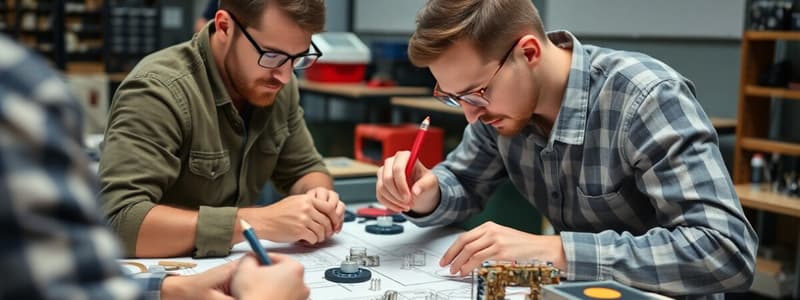Podcast
Questions and Answers
In the engineering design process, what is the primary purpose of building a prototype?
In the engineering design process, what is the primary purpose of building a prototype?
- To test the concept and gather performance data. (correct)
- To finalize the design for mass production.
- To create a visually appealing product.
- To showcase the product to potential investors.
Science primarily focuses on applying scientific principles to solve real-world problems, whereas engineering seeks to understand the natural world.
Science primarily focuses on applying scientific principles to solve real-world problems, whereas engineering seeks to understand the natural world.
False (B)
Define the purpose of a null hypothesis in the context of designing an experiment.
Define the purpose of a null hypothesis in the context of designing an experiment.
A null hypothesis assumes no effect or relationship exists between variables being tested.
In experimental design, a variable that is kept constant to prevent it from influencing the outcome is known as a ______ variable.
In experimental design, a variable that is kept constant to prevent it from influencing the outcome is known as a ______ variable.
Match the following states of matter changes with their correct description:
Match the following states of matter changes with their correct description:
Which of the following best describes the relationship between air pressure and wind?
Which of the following best describes the relationship between air pressure and wind?
Global wind patterns, such as trade winds and westerlies, are primarily caused by ocean currents.
Global wind patterns, such as trade winds and westerlies, are primarily caused by ocean currents.
Briefly describe the role of convection cells in global air circulation.
Briefly describe the role of convection cells in global air circulation.
In thunderstorm formation, lightning is caused by the equalization of electrical ______ within the cloud.
In thunderstorm formation, lightning is caused by the equalization of electrical ______ within the cloud.
Match the ocean current driving force with its description:
Match the ocean current driving force with its description:
According to Charles’s Law, what happens to the volume of a gas if the temperature increases while the pressure remains constant?
According to Charles’s Law, what happens to the volume of a gas if the temperature increases while the pressure remains constant?
Bernoulli's Principle states that as the speed of a fluid decreases, its pressure decreases.
Bernoulli's Principle states that as the speed of a fluid decreases, its pressure decreases.
Explain in a sentence how Bernoulli's Principle is applied in the design of airplane wings.
Explain in a sentence how Bernoulli's Principle is applied in the design of airplane wings.
The most abundant gas in Earth's atmosphere, making up approximately 78%, is ______.
The most abundant gas in Earth's atmosphere, making up approximately 78%, is ______.
Match the layers of the atmosphere with their defining characteristics:
Match the layers of the atmosphere with their defining characteristics:
Which layer of the atmosphere contains the ozone layer, which absorbs harmful UV radiation from the sun?
Which layer of the atmosphere contains the ozone layer, which absorbs harmful UV radiation from the sun?
The exosphere is the hottest layer of the atmosphere, characterized by extremely high temperatures due to its proximity to the sun.
The exosphere is the hottest layer of the atmosphere, characterized by extremely high temperatures due to its proximity to the sun.
Briefly describe what happens to meteors in the mesosphere.
Briefly describe what happens to meteors in the mesosphere.
The phenomenon of auroras, such as the Northern Lights, occurs within the ______ layer of the atmosphere due to ionized gases.
The phenomenon of auroras, such as the Northern Lights, occurs within the ______ layer of the atmosphere due to ionized gases.
Which of the following is a critical step in the 'Refine and Iterate' stage of the engineering design process?
Which of the following is a critical step in the 'Refine and Iterate' stage of the engineering design process?
Flashcards
Identify the Problem
Identify the Problem
Recognize the issue that needs solving and gather background information.
Define Requirements
Define Requirements
Establish criteria the solution must meet.
Research and Brainstorm
Research and Brainstorm
Investigate existing solutions and brainstorm multiple ideas.
Develop Solutions
Develop Solutions
Signup and view all the flashcards
Build a Prototype
Build a Prototype
Signup and view all the flashcards
Refine and Iterate
Refine and Iterate
Signup and view all the flashcards
Communicate Results
Communicate Results
Signup and view all the flashcards
Science
Science
Signup and view all the flashcards
Engineering
Engineering
Signup and view all the flashcards
Hypothesis
Hypothesis
Signup and view all the flashcards
Null Hypothesis (H0)
Null Hypothesis (H0)
Signup and view all the flashcards
Independent Variable
Independent Variable
Signup and view all the flashcards
Dependent Variable
Dependent Variable
Signup and view all the flashcards
Deposition
Deposition
Signup and view all the flashcards
Sublimation
Sublimation
Signup and view all the flashcards
Precipitation
Precipitation
Signup and view all the flashcards
Wind
Wind
Signup and view all the flashcards
Trade Winds
Trade Winds
Signup and view all the flashcards
Bernoulli's Principle
Bernoulli's Principle
Signup and view all the flashcards
Troposphere
Troposphere
Signup and view all the flashcards
Study Notes
- Engineering Design Process is a process to solve issues.
Engineering Design Process
- Identify the core problem.
- Gather background information on the problem.
- Define the requirements that the solution must meet in order to solve the problem.
- Research existing solutions to see if there are opportunities to improve.
- Brainstorm new solutions to the problem.
- Develop solutions and create initial concepts and models.
- Evaluate the feasibility of the concepts.
- Build a prototype.
- Test the prototype to see how it performs.
- Collect data and evaluate against goals.
- Refine and iterate to improve the design based on tests.
- Continuously improve solution until requirements are met.
- Communicate results to stakeholders.
Engineering vs Science
- Science's aim is to understand the natural world.
- Science seeks to discover underlying principles, laws, and phenomena such as studying the behavior of gases in various conditions.
- Engineering applies scientific principles to solve real-world problems.
- Engineering focuses on creating solutions, structures, or systems such as designing a more efficient engine.
Hypothesis and Experiment Design
- A hypothesis is a testable prediction about the outcome of an experiment.
- A null hypothesis (H0) assumes no effect or relationship.
- Null Hypothesis example: increasing temperature has no effect on the rate of reaction.
Experiment Design
- Independent Variable: This is changed during the experiment.
- Dependent Variable: This is measured.
- Control Variables: These stay constant.
- Sample Size: Should be large enough for accuracy.
- Procedure: Follow clear steps to conduct the experiment.
- Collect Data: Record observations and measurements.
- Analyze Results: Compare with the hypothesis and draw conclusions.
- Conclusion: Determine whether the hypothesis is supported.
States of Matter and Changes
- Solid turns to liquid (Melting) when energy is added, molecules move more freely.
- Liquid turns to gas (Evaporation) when molecules gain enough energy to overcome the liquid's surface tension.
- Gas turns to liquid (Condensation) when molecules lose energy and bond together.
- Liquid turns to solid (Freezing) when molecules lose energy and slow down.
- Gas turns to solid (Deposition) when gas turns directly into a solid without becoming liquid.
- Solid turns to gas (Sublimation) when a solid directly turns into a gas without becoming a liquid.
Weather patterns/Precipitation
- Water vapor in the air condenses into liquid or solid forms due to cooling (rain, snow, hail).
- Clouds form as the air cools and moisture condenses.
- Precipitation occurs when the condensed water droplets become too heavy to remain suspended in the cloud.
Wind
- Air moves from high-pressure areas to low-pressure areas.
- The Earth's rotation (Coriolis effect) and uneven heating of Earth's surface create wind patterns.
- Wind is affected by geographic features like mountains and valleys.
Air Currents
- Uneven heating of the Earth's surface creates differences in temperature and pressure and causes air currents.
- Warm air rises creating lower pressure.
- Cool air moves in to replace it, creating higher pressure.
Global Wind Patterns
- Trade Winds: Move from east to west in the tropics.
- Westerlies: Move from west to east in the mid-latitudes.
- Polar Easterlies: Move from east to west in polar regions.
Convection Cells
- Warm air rises at the equator, cools, and sinks at the poles.
- Convection cells create air circulation patterns (Hadley, Ferrel, and Polar cells).
Thunderstorm Formation
- Warm, moist air rises from the Earth's surface due to the sun's heating.
- Air cools and condenses, forming clouds.
- This process builds electrical charges within the cloud.
- Lightning occurs when the charges equalize.
- Thunder is the sound produced by the rapidly heated air.
Ocean Currents
- Wind drives surface currents.
- Temperature differences: Cold water sinks and warm water rises, helping create deep ocean currents.
- Earth's rotation (Coriolis effect) influences the direction of ocean currents.
- Salinity: Saltwater is denser, so it sinks, influencing vertical currents.
Important Currents
- Gulf Stream: Warm current from the Gulf of Mexico to the North Atlantic.
- California Current: Cold current along the western coast of North America.
Temperature Affects Pressure
- Temperature and pressure are related in gases.
- As Temperature increases molecules move faster and spread out.
- An increase in temperature increases the pressure if the volume is constant.
- Boyle’s Law: At constant temperature, pressure and volume are inversely proportional.
- Charles’s Law: At constant pressure, volume and temperature are directly proportional.
Bernoulli's Principle
- As the speed of a fluid increases, its pressure decreases.
- Airplane wings, the faster air over the top of the wing lowers pressure, creating lift, showing Bernoulli's Principle in action.
- Venturi Effect, fluid speeds up in a narrow passage, causing pressure to drop, showing Bernoulli's Principle in action.
Percent of Gases in the Atmosphere
- Nitrogen (N₂): ~78%
- Oxygen (O₂): ~21%
- Argon (Ar): ~0.93%
- Carbon Dioxide (CO₂): ~0.04%
- Other Gases: Trace amounts (e.g., neon, helium).
Layers of the Atmosphere Properties
- Troposphere: Closest to Earth’s surface, weather occurs here, and temperature decreases with altitude.
- Stratosphere: Contains the ozone layer, which absorbs UV radiation, and temperature increases with altitude.
- Mesosphere: Coldest layer where meteors burn up.
- Thermosphere: Very hot, with temperatures rising sharply, contains ionized gases (auroras).
- Exosphere: Outermost layer with very thin air, where particles escape into space.
Studying That Suits You
Use AI to generate personalized quizzes and flashcards to suit your learning preferences.




